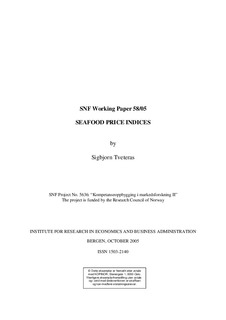| dc.description.abstract | The new FAO seafood price indices have been constructed based on import statistics for USA and the European Union. The main objective of the FAO seafood import price indices is to indicate quarterly to annual price trends for key seafood products. Two previous FAO studies have presented seafood price indices together with issues and methodologies involved with constructing them (Kiel, 1993; Doglia, 1999). This study builds on those two, but here we take advantage of the increased availability of seafood trade statistics through the Internet.
The price indices presented here only cover a small part of global seafood trade, which imply that numerous seafood markets have been omitted. The scope was limited to keep the workload at manageable proportions. Fresh salmon, frozen shrimp, frozen cod and canned tuna products in the EU and the US markets are targeted for the price indices. Most indices start from January 1989 or early 1990s. The selection covers two of the largest seafood markets (Japanese seafood imports are larger than the US in value, but is disregarded because of less accessible trade statistics). Likewise, the products are in terms of value among the most important in international seafood trade.
There are clear advantages of focusing on such widely traded products: (1) because of their importance in seafood trade, they can be indicative for the price of a number of related seafood products, (2) more reliable and consistent data are available for these products compared with many other seafood products, and (3) by limiting the selection to a few key products and key markets the work will be kept at manageable proportions. The FAO seafood price indices are representative for a limited number of species and markets.
The performance of the price indices is compared against price data for similar products from the Globefish databank. Overall the unit values mimic prices better than what might initially have been expected. For several reasons, however, there can be considerable discrepancies between price-based index and the FAO unit value based import price indices. Similar but not identical products are being compared, the unit values suffer from compositional effects, and the lag effect in trade data all contribute to the discreapancies. Despite these discrepancies the unit values indices appear to capture the major price trends in the markets. Statistical tests provide further evidence that there is a strong relationship between the unit values and prices series in the long run. | en |
